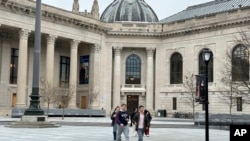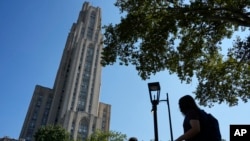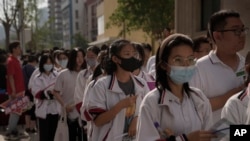Student Union
Sexual Assault in Schools Kept Quiet, Unpunished: Part 2

Student sexual assaults by peers were far more common than those by adults or teachers over four years until 2015, according to an AP yearlong investigation.
There were seven assaults by students for every adult-on-child sexual attack reported on school property, AP's analysis of the federal crime data showed.
Schools frequently were unwilling or ill-equipped to address the problem, AP found, despite having long been warned by the U.S. Supreme Court that they could be liable for monetary damages. Some administrators and educators even engaged in cover-ups to hide evidence of a possible crime and protect their schools' image.
"No principal wants their school to be the rape school, to be listed in the newspaper as being investigated. Schools try to bury it. It's the courageous principal that does the right thing," said Dr. Bill Howe, a former K-12 teacher who spent 17 years overseeing Connecticut's state compliance with Title IX, the federal law used to help protect victims of sexual assault in schools.
Laws and legal hurdles also favor silence. Schools have broadly interpreted rules protecting student and juvenile privacy to withhold basic information about sexual attacks from their communities. Victims and their families face high legal thresholds to successfully sue school districts for not maintaining safe learning environments.
"Everyone feels like we don't have a problem, and the reason they feel that way is they have their heads in the sand," said Oregon psychologist Wilson Kenney, who has helped develop student intervention programs.
Student-on-student sexual assaults live in the shadows compared to the attention paid to gun violence in schools, Kenney noted.
Chaz Wing's legal fight with Brunswick Junior High offers a rare insight into a school investigation of student sexual assault allegations.
The AP reviewed about 1,500 pages of sworn testimony, emails, court documents and investigative reports, as well as videotaped depositions of 15 school administrators, teachers and police, and interviews with a dozen people tied to the case.
School and district officials declined AP's interview requests. So did parents of some of the students accused in the attacks, except to say their sons were innocent.
The AP does not usually name alleged victims of sexual assault, but Wing and his parents decided to speak publicly in hopes of helping others.
"I don't want this to happen to other kids," said his mother, Amy Wing.
WARNING SIGNS
From Wing's first days at Brunswick Junior High in September 2010, teachers say it was clear he was the type of kid bullies would target.
Overweight with a brown mullet, he had unpopular opinions and wasn't shy about expressing them. He despised sports, video games and pop music. When other boys showed up for a class project in soccer jerseys, he displayed his love of gardening by wearing a hat and gloves, carrying a trowel and handing out flower-shaped sugar cookies.
Early on, Wing testified in his lawsuit, several boys cornered him at his locker, mocking him and calling him fat. They relentlessly harassed him with the "gay test," a light touch on his shoulder that if he didn't notice for 10 seconds, indicated he was gay, the bullies said. Before long, half the boys in the class were doing it.
Wing complained dozens and dozens of times to teachers, his guidance counselor and the principal. He complained so often that he came to be seen as an overly sensitive nuisance.
One teacher asked Wing if he was gay, he testified. "I told her 'no' and she said then don't worry about it."
Brunswick Principal Walter Wallace had formed an anti-bullying committee shortly after joining the school. In early 2010, Wallace testified that Brunswick students participated in a survey in which 1 in 6 pupils reported being regularly physically victimized. Wallace implemented a system for documenting student abuse, but it recorded only complaints that were confirmed and then only in the files of the accused, not the victim.
Wing and his mother met with Wallace, but they said the bullying continued.
Wing entered Brunswick Junior High with a "gifted and talented" designation, but by the time he started seventh grade in fall 2011, his academic marks had dropped. His harassment complaints were consuming so much of teachers' time that they asked Wallace and his vice principal to take over.
"It wasn't happening when we were watching and we were trying to keep a close eye on it," one teacher testified, "but it was always around the corner and away from us."
The principal said he thought Wing was becoming overly sensitive and made many reports teachers could not substantiate. But Wing's seventh-grade counselor, Bunny Andrews, testified that she became "very, very concerned" as incidents began to pile up.
Wing "was bullied," she said. "I could never deny that."
The physical torment escalated dramatically, Wing testified: In November 2011, he said, he was sexually assaulted by classmates.
According to the lawsuit, the boys crawled under the door of the bathroom stall, put the blade of a small knife against his wrist, ordered him to the ground and overpowered him. One boy threatened to burn down his house, harm his family and kill his pets if anyone found out — then sliced into his right arm.
By the following February, a similar second incident occurred, Wing testified. He was changing clothes for gym in a locker-room stall because he felt self-conscious about his looks, he said. A boy pushed his way in as a second boy stood guard outside.
Wing was assaulted, he said. He stayed silent, he said, cowed by the threats of the first assault. A third rape occurred. Again, Wing didn't speak out, he said, because he was afraid.
Still, records show the school knew Wing's bullying had become more physical, including an attack he reported in which he was stabbed with a pencil, with the lead breaking off in his arm. A teacher began escorting him between classes, but Wing declined after two days.
"Please, just don't. This is making things worse."
Two weeks after Grade 7 ended, Amy Wing filed a complaint with the Maine Human Rights Commission — kicking off the legal fight that lasted more than four years.
Associated Press journalists Robin McDowell reported from Brunswick; Reese Dunklin and Emily Schmall from Dallas; and Justin Pritchard from Los Angeles. Part 3 of this series will be published tomorrow.
Please leave a comment here, and visit us on Facebook, Twitter, Instagram and LinkedIn, thanks!
See all News Updates of the Day
- By VOA News
Competition grows for international students eyeing Yale

It’s tough to gain admission to Yale University, and it’s getting even tougher for international students as standout students from around the world set their sights on Yale.
The Yale Dale News, the campus newspaper, takes a look at the situation here.
- By VOA News
Student from Ethiopia says Whitman College culture made it easy to settle in

Ruth Chane, a computer science major from Ethiopia, writes about her experiences settling into student life at Whitman College in the U.S. state of Washington.
"The community at Whitman College made sure I felt welcomed even before I stepped foot on campus," she says.
- By VOA News
Claremont Colleges student gets a shock when she heads home to Shanghai

In The Student Life, the student newspaper for the Claremont Colleges, a consortium of five liberal art colleges and two graduate schools in Claremont, California, student Rochelle Lu writes about readjusting to her Shanghai home after spending a semester in the United States.
- By VOA News
Cedarville University aims to ease transition for international students

Cedarville University in the U.S. state of Ohio says it’s got more than 140 international students representing 44 countries.
Here, the school interviews Jonathan Sutton, director of international student services. He talks about his job and the opportunities for international students on campus.
- By VOA News
Morehouse College offers prospective students tips on applying and thriving

Morehouse College, a private, historically Black liberal arts college in the U.S. state of Georgia, offers a guide for international students interested in attending the school.
Among the tips to apply and thrive at Morehouse:
- Take advantage of the school’s orientation program
- Turn to the school’s Center for Academic Success for tutoring, support and more
- Immerse yourself in campus life via clubs and societies
- By Reuters
US reviews Columbia University contracts, grants over antisemitism allegations

The administration of President Donald Trump said on Monday it will review Columbia University's federal contracts and grants over allegations of antisemitism, which it says the educational institution has shown inaction in tackling.
Rights advocates note rising antisemitism, Islamophobia and anti-Arab bias since U.S. ally Israel's devastating military assault on Gaza began after Palestinian Hamas militants' deadly October 2023 attack.
The Justice Department said a month ago it formed a task force to fight antisemitism. The U.S. Departments of Health and Education and the General Services Administration jointly made the review announcement on Monday.
"The Federal Government's Task Force to Combat Anti-Semitism is considering Stop Work Orders for $51.4 million in contracts between Columbia University and the Federal Government," the joint statement said.
The agencies said no contracting actions had been taken yet.
"The task force will also conduct a comprehensive review of the more than $5 billion in federal grant commitments to Columbia University."
The agencies did not respond to requests for comment on whether there were similar reviews over allegations of Islamophobia and anti-Arab bias.
Columbia had no immediate comment. It previously said it made efforts to tackle antisemitism.
College protests
Trump has signed an executive order to combat antisemitism and pledged to deport non-citizen college students and others who took part in pro-Palestinian protests.
Columbia was at the center of college protests in which demonstrators demanded an end to U.S. support for Israel due to the humanitarian crisis caused by Israel's assault on Gaza. There were allegations of antisemitism and Islamophobia in protests and counter-protests.
During last summer's demonstrations around the country, classes were canceled, some university administrators resigned and student protesters were suspended and arrested.
While the intensity of protests has decreased in recent months, there were some demonstrations last week in New York after the expulsion of two students at Columbia University-affiliated Barnard College and after New York Governor Kathy Hochul ordered the removal of a Palestinian studies job listing at Hunter College.
A third student at Barnard College has since been expelled, this one related to the occupation of the Hamilton Hall building at Columbia last year.
Canada’s immigration overhaul signals global shift in student migration
From Europe to North America, nations are tightening their immigration policies. Now Canada, long seen as one of the world's most welcoming nations, has introduced sweeping changes affecting international students. The reforms highlight a growing global trend toward more restrictive immigration policies. Arzouma Kompaore reports from Calgary.
Trump administration opens antisemitism inquiries at 5 colleges, including Columbia and Berkeley

The Trump administration is opening new investigations into allegations of antisemitism at five U.S. universities including Columbia and the University of California, Berkeley, the Education Department announced Monday.
It's part of President Donald Trump's promise to take a tougher stance against campus antisemitism and deal out harsher penalties than the Biden administration, which settled a flurry of cases with universities in its final weeks. It comes the same day the Justice Department announced a new task force to root out antisemitism on college campuses.
In an order signed last week, Trump called for aggressive action to fight anti-Jewish bias on campuses, including the deportation of foreign students who have participated in pro-Palestinian protests.
Along with Columbia and Berkeley, the department is now investigating the University of Minnesota, Northwestern University and Portland State University. The cases were opened using the department's power to launch its own civil rights reviews, unlike the majority of investigations, which stem from complaints.
Messages seeking comment were left with all five universities.
A statement from the Education Department criticized colleges for tolerating antisemitism after Hamas' Oct. 7, 2023, attack on Israel and a wave of pro-Palestinian protests that followed. It also criticized the Biden administration for negotiating "toothless" resolutions that failed to hold schools accountable.
"Today, the Department is putting universities, colleges, and K-12 schools on notice: this administration will not tolerate continued institutional indifference to the wellbeing of Jewish students on American campuses," said Craig Trainor, the agency's acting assistant secretary for civil rights.
The department didn't provide details about the inquiries or how it decided which schools are being targeted. Presidents of Columbia and Northwestern were among those called to testify on Capitol Hill last year as Republicans sought accountability for allegations of antisemitism. The hearings contributed to the resignation of multiple university presidents, including Columbia's Minouche Shafik.
An October report from House Republicans accused Columbia of failing to punish pro-Palestinian students who took over a campus building, and it called Northwestern's negotiations with student protesters a "stunning capitulation."
House Republicans applauded the new investigations. Representative Tim Walberg, chair of the Education and Workforce Committee, said he was "glad that we finally have an administration who is taking action to protect Jewish students."
Trump's order also calls for a full review of antisemitism complaints filed with the Education Department since Oct. 7, 2023, including pending and resolved cases from the Biden administration. It encourages the Justice Department to take action to enforce civil rights laws.
Last week's order drew backlash from civil rights groups who said it violated First Amendment rights that protect political speech.
The new task force announced Monday includes the Justice and Education departments along with Health and Human Services.
"The Department takes seriously our responsibility to eradicate this hatred wherever it is found," said Leo Terrell, assistant attorney general for civil rights. "The Task Force to Combat Anti-Semitism is the first step in giving life to President Trump's renewed commitment to ending anti-Semitism in our schools."
- By VOA News
STEM, business top subjects for international students

The Times of India breaks down the most popular subjects for international students to study in the U.S.
STEM and business lead the pack. Read the full story here. (January 2025)
- By VOA News
Safety and visa difficulties among misconceptions about US colleges

U.S. News & World report addresses some of the misconceptions about U.S. colleges and universities, including the difficulty of getting a visa.
Read the full story here. (January 2025)
- By VOA News
Work opportunities help draw international students to US schools

US News & World Report details the three top factors in foreign students' decision to study in the U.S. They include research opportunities and the reputation of U.S. degrees. Read the full story here. (December 2024)
- By VOA News
British student talks about her culture shock in Ohio

A British student who did a year abroad at Bowling Green State University in Ohio talks about adjusting to life in America in a TikTok video, Newsweek magazine reports.
Among the biggest surprises? Portion sizes, jaywalking laws and dorm room beds.
Read the full story here. (December 2024)
- By VOA News
Harvard's Chan School tells international students what to expect

Harvard's T.H. Chan School of Public Health reaches out to international students by detailing the international student experience at the school.
Learn more about housing, life in Boston and more here.
- By Reuters
China unveils plan to build 'strong education nation' by 2035

China issued its first national action plan to build a "strong education nation" by 2035, which it said would help coordinate its education development, improve efficiencies in innovation and build a "strong country."
The plan, issued Sunday by the Communist Party's central committee and the State Council, aims to establish a "high quality education system" with accessibility and quality "among the best in the world."
The announcement was made after data on Friday showed China's population fell for a third consecutive year in 2024, with the number of deaths outpacing a slight increase in births, and experts cautioning that the downturn will worsen in the coming years.
High childcare and education costs have been a key factor for many young Chinese opting out of having children, at a time when many face uncertainty over their job prospects amid sluggish economic growth.
"By 2035, an education power will be built," the official Xinhua news agency said, adding that China would explore gradually expanding the scope of free education, increase "high-quality" undergraduate enrolment, expand postgraduate education, and raise the proportion of doctoral students.
The plan aims to promote "healthy growth and all-round development of students," making sure primary and secondary school students have at least two hours of physical activity daily, to effectively control the myopia, or nearsightedness, and obesity rates.
"Popularizing" mental health education and establishing a national student mental health monitoring and early warning system would also be implemented, it said.
It also aims to narrow the gap between urban and rural areas to improve the operating conditions of small-scale rural schools and improve the care system for children with disabilities and those belonging to agricultural migrant populations.
The plan also aims to steadily increase the supply of kindergarten places and the accessibility of preschool education.
- By VOA News
A look at financial aid options for international graduate students in US

The Open Notebook, a site focusing on educating journalists who cover science, has complied a list of U.S. graduate program financial aid information for international students.








